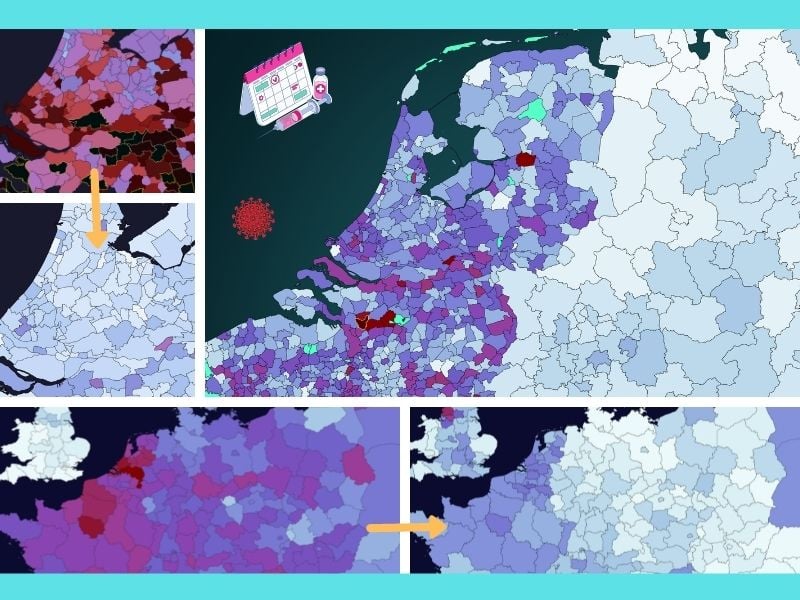
Slowly but surely, normal life is returning to Europe. Where in April the first easings of restrictions were initiated, it is almost a summertime mood now. The Eurovision Song Festival is behind us and tonight the European Football Championship begins in countries across the continent. Just like last it did around this time last year, the pandemic seems to be fading more and more into the background.
Is this justified? If we are to believe the figures of recent weeks, most definitely. The vaccines are apparently doing an excellent job. Almost all EU countries have now got their act together and their supplies under control. Following Germany and Belgium, the Netherlands has also clearly stepped on the gas pedal. It is quite surprising that the Scandinavian countries are at risk of lagging behind a bit. To kick off this week’s column, here is a recap of that other European Championship that has been going on since the beginning of January.
Lightest maps to date
What effect has the rollout of vaccination programmes had on the number of infections? Huge. That should be obvious by now to anyone who has not been living under a rock. After the red colors disappeared from the slider charts at the beginning of May, it is now a case of looking for the purple hues. In fact, every country is reporting impressive declines in new cases. So much so that hospitals are no longer in danger of succumbing to the pressure.
This picture becomes clear at a glance with the sliders below, where the week from 4 to 10 June is juxtaposed with those of two and six weeks ago. This week we have a first: One part of Europe has kept its zero for seven days, so that for the first time in 2021, a tiny green patch can be spotted somewhere in the middle of the boot of Italy. Congratulations San Marino!
Front runner under duress
Almost everywhere, new Covid reports are falling to values within the safe margins. The celebration party had already started back in April in Great Britain. Due to the fact that they were a few months ahead because of their huge stock of AstraZeneca vaccines, the lockdown could be lifted in April. However, less than two months later, it seems that this jubilation is no longer there. That’s owing to an ever-growing Indian elephant of microscopic proportions. Within weeks, Lancashire, Manchester and parts of Scotland became some of the worst viral hotbeds in Europe.

Cheered too early?
In early June, the surge throughout the UK may be delaying the end date of the coronas measures set for 21 June. This is all due to the spread of the Indian Type II, now renamed the Delta variant. Besides those who are unvaccinated, a lot of people are still waiting for their second shot. And teenagers are also testing positive. It is therefore not surprising that more and more voices are being raised in favor of sending this younger age group an invitation for a vaccination appointment soon.
Although it is important to emphasize that these figures do not mirror the same disastrous situation as last year. Yes, the increase is significant. But the age groups now affected are younger and less likely to develop severe symptoms. Also, one shot alone already prevents the lion’s share of severe disease symptoms. However, this does show that the pandemic is still not over, even at this stage.
For more background on the spread of the Delta variant in the UK, news media outlets such as The Guardian, the BBC and Dr. John Campbell’s YouTube channel provide excellent explainers. So far, there doesn’t seem to be any “British conditions” elsewhere in Europe. Indeed, on the other side of the North Sea, the maps of the Netherlands are looking friendlier than ever. Here is the difference from two and six weeks ago at the municipal level.
Corona in Germany and the Benelux
Because the legend on the slider charts cannot be adjusted, this map of the Netherlands now looks very light. This, of course, does look very hopeful. But in fact it offers a somewhat distorted picture and does not show the regional disparities very clearly when the prevalence of the virus is lower. You may notice that on the map of Europe, the Netherlands is significantly darker in color. This has everything to do with the lower threshold values for certain colors.
That there is still much to be gained is shown by this week’s unique special closure map in which the Dutch and Belgian municipalities are pitted against the German Landkreise. Yes, things are going quite well. Although according to the standards of the German Robert Koch Institute, almost the entire Benelux is still scoring unsatisfactorily. Will we drop down to the German levels before the end of the month? Or will we start ramping up again like the British instead? This will all become clear over the coming weeks.


